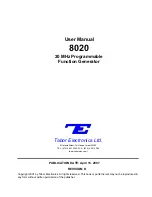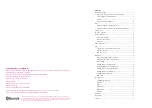
15
16
OPERATION
Always turn the battery switch to the “OFF”
position when unit is not in use, this will stop the
battery from being drained. Follow the maintenance
and storage instructions for the generator and
battery when the unit will not be used for a period
of 2 weeks or more.
NOTE
Do Not Overload Generator
Capacity
Follow these simple steps to calculate the running and
starting watts necessary for your purposes.
1. Select the electrical devices you plan on running at
the same time.
2. Total the running watts of these items. This is
the amount of power you need to keep your items
running.
3. Identify the highest starting wattage of all devices
identified in step 1. Add this number to the number
calculated in step 2. Surge wattage is the extra
burst of power needed to start some electric driven
equipment. Following the steps listed under “Power
Management” will guarantee that only one device
will be starting at a time.
Power Management
Use the following formula to convert voltage and
amperage to watts:
Volts x Amps = Watts
To prolong the life of your generator and attached
devices, follow these steps to add electrical load:
1. Start the generator with no electrical load attached.
2. Allow the engine to run for several minutes to
stabilize.
3. Plug in and turn on the first item. It is best to
attach the item with the largest load first.
4. Allow the engine to stabilize.
5. Plug in and turn on the next item.
6. Allow the engine to stabilize.
7. Repeat steps 5-6 for each additional item.
Never exceed the specified capacity when adding
loads to the generator.
NOTE
Stopping the Engine
1. Turn off and unplug all electrical loads. Never start
or stop the generator with electrical devices plugged
in or turned on.
2. Let the generator run at no-load for several minutes
to stabilize internal temperatures of the engine and
generator.
3. Turn the Fuel Valve to the “OFF” position if
operating by petrol.
4. Turn the LPG cylinder knob to the “CLOSE” or off
position if operating by LPG.
5. Let the engine run until fuel starvation has stopped
the engine. This usually takes a few minutes.
6. Press the ignition switch to the “OFF” position.
7. Turn battery switch to the “Off” Position.
Important:
Always ensure that the fuel valve and the
ignition switch are in the “OFF” position when the
engine is not in use.
When turning off the generator after LPG operation,
make sure the LPG cylinder knob is in the fully
closed position.
NOTE
If the engine will not be used for a period of two (2)
weeks or longer, please see the Storage section for
proper engine and fuel storage.
NOTE
Overload Operation
The overload indicator light will turn on when the rated
load is exceeded. When the maximum load is reached,
the LED will blink and cut power to the receptacles. To
recover the power, shut down the engine, wait until the
light turns off and restart the generator.
OPERATION
Operation at High Altitude
The density of air at high altitude is lower than at sea
level. Engine power is reduced as the air mass and air-
fuel ratio decrease. Engine power and generator output
will be reduced approximately 3½% for every 1000 ft.
of elevation above sea level. This is a natural trend and
cannot be changed by adjusting the engine. At high
altitudes increased exhaust emissions can also result
due to the increased enrichment of the air fuel ratio.
Other high altitude issues can include hard starting,
increased fuel consumption and spark plug fouling.
Smart Charger
The smart charger (included) is a device that is used to
charge the generator battery. The smart charger plugs
into the generator, into the DC input on the front panel,
and then into a household outlet power source. There
is a light on the charger. If the battery is in need of a
charge or charging then the red light will light up. If
the battery is good and not in need of charging or has
completed charging then the green light will light up.
The smart charger is programmed not to charge or to
stop charging when the light is green. This is a safety
feature that will help prevent damage to the battery and
generator.
If the battery is completely dead, and won’t hold a
charge, then the smart charger can be plugged into
a power source to enable power to the choke.
NOTE
SMART CHARGER 12V DC
Summary of Contents for 73001i-DF (EU)
Page 16: ...Page intentionally left blank Page intentionally left blank ...
Page 17: ......



































